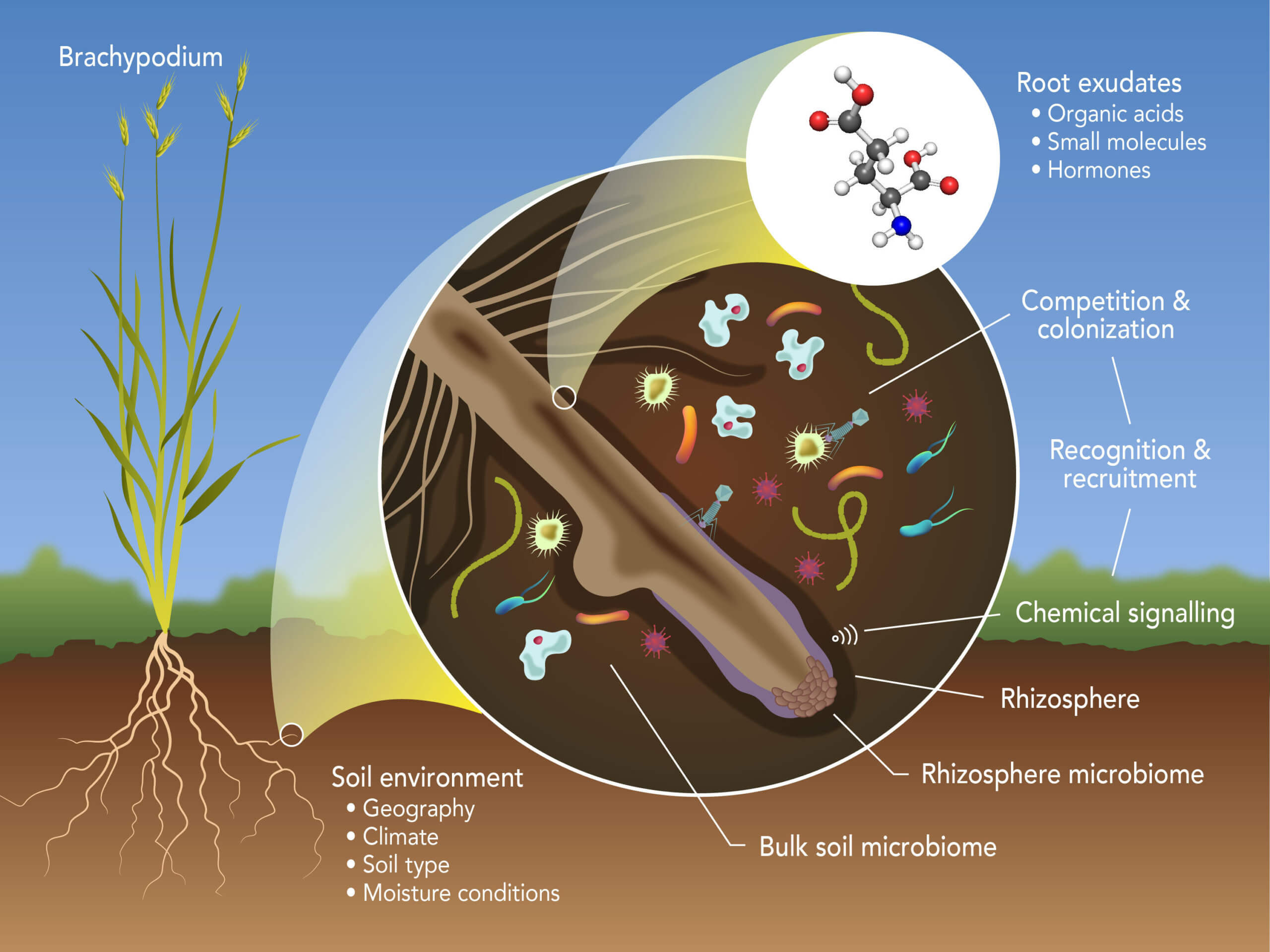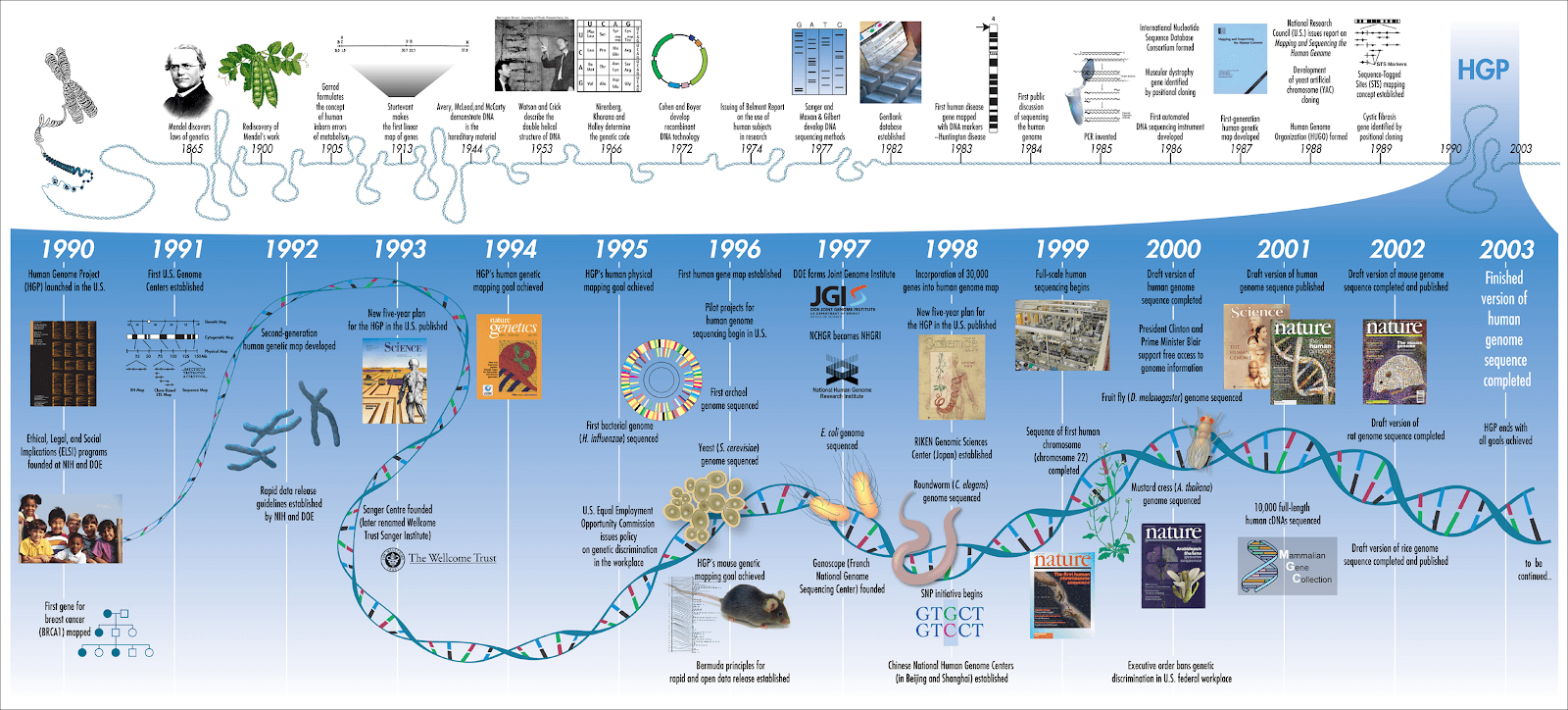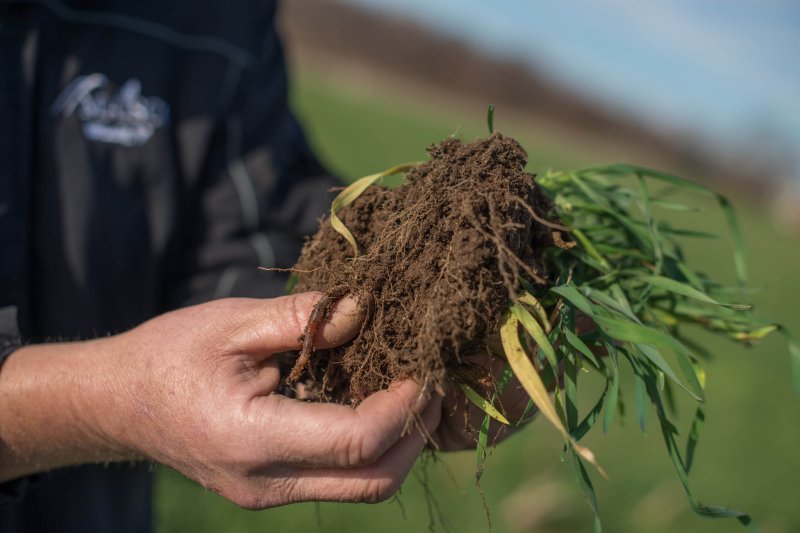Research into the soil microbiome has already led to biotech developments capable of improving crop yields while lowering input use and reducing fertilizer-related emissions and runoff — the full use of existing microbial biotech products can reduce GHG emissions from agriculture by 16 MMT CO2 e/year. Biofertilizers, microbial inoculants, and other soil microbiological developments can help farmers achieve long-term goals of economic viability and environmental sustainability.
While there has been much political and activist interest in using soil carbon sequestration as a source of carbon offsets and agricultural emissions mitigation — cover crops, for example, have the potential to reduce emissions by around 100 MMT CO2 e/year — agricultural practices that sequester carbon require further research to validate their benefits.
By creating an interagency soil science initiative, and utilizing the benefits of mission-oriented research programs, the government would create an environment capable of long-term innovation in soil microbiology, improve our understanding of soil carbon sequestration, and ensure a prosperous and sustainable future for American agriculture.
Introduction
US agriculture has been hit hard by COVID-19. Farmers face falling prices, shrinking export markets, and increasingly hazardous labor conditions and shortages. These synchronous agricultural crises place rural and semi-rural communities in dire straits.1
While the difficulties facing US agriculture have no silver-bullet solution, agricultural research and development (R&D) is an important step toward boosting economic outcomes for farmers while combating climate change. Historically, publicly funded agricultural R&D played a key role in increasing productivity, economic development, and American pre-eminence among global agricultural producers.2
Today, R&D related to soil science is a promising option to help address these multifaceted challenges in agriculture. Advances in soil science, particularly regarding soil microbiomes, have the potential to increase farm yields and income while reducing nitrogen runoff, improving soil health, sequestering carbon, and reducing greenhouse gas emissions.3 To maximize these benefits, the federal government should create and invest in a soil science initiative.

Such an initiative should be aimed at the development of technological breakthroughs in soil microbiology through the creation of a soil microbiome research hub, and the identification and validation of soil carbon sequestration practices through academic or public research. Increased funding and coordination of soil science in the United States can lead to both short-term environmental and economic benefits, and longterm sustainable, green growth for American agricultural producers.
Current federal funding for soil science R&D
Current federal funding for soil science remains modest and without clear priorities. In total, the US federal government funds around $180 million of soil science R&D per year, equivalent to only 0.1% of total US federal R&D spending.4 This funding comes from several agencies and organizations: the National Institute of Food and Agriculture (NIFA), the Agricultural Research Service (ARS), the Foundation for Food and Agriculture Research (FFAR), the National Science Foundation (NSF), and the Department of Energy (DOE). Of these organizations, only ARS and FFAR list “soils” as a priority or “challenge” area of research. By contrast, in NIFA’s 2014-2018 strategic plans, the agency only mentions “soils” once, while mentioning “bioenergy” seven times.5

Federal programs for soil science R&D also suffer from a lack of coordination. For example, NIFA, NSF, FFAR, DOE, and ARS all fund research into soil sensor technologies, effectively funnelling research dollars into a subset of soil scientists instead of funding research and development across the spectrum of the discipline. While a lack of coordination does not preclude advances in the field, it severely limits short term R&D output and the long-term potential for scientific and technological breakthroughs.
With modest resources concentrated in few research areas, there is little reason to expect groundbreaking research.
The case for a soil science research initiative
To revitalize US agriculture, the federal government should create a research initiative centered solely on soil science R&D, and fund it accordingly. This initiative could work to coordinate priorities across federal agencies and other stakeholders — such as the Tri-Societies, land-grant university research centers, federal laboratories, and producer networks — while funding and advancing R&D programs in-house.
Policymakers ought to learn from the latest innovation policy research and design the initiative to follow a mission-oriented and applied research framework.6,7,8
Scholarship has attributed the success of mission-oriented research to two main factors. First, mission-oriented research directs focus on “concrete societal problems that can only be solved by multiple sectors interacting in new ways,” rather than funding basic research without a clear, direct application.9 The success of the Defense Advanced Research Projects Agency (DARPA) in spurring innovation both inside and outside of the military, for example, demonstrates the ability of mission-oriented research to set agendas and bring stakeholders together to target a specific challenge.10
Second, mission-oriented research initiatives build and foster networks capable of solving problems and innovating.11 For example, the Human Genome Project, a multi-institutional project funded by the National Institute of Health and the Department of Energy, to map the human genome succeeded in large part because of the decision to construct a network of researchers and organizations across state and national borders.12 Mission-oriented research initiatives can effectively avoid “network failures” — instances “when economic actors are unable to find appropriate network partners who are both competent and trustworthy.”13 Because innovation occurs through networked organizations and collaborations — especially technological and systematic innovation — network failures can stall and dampen innovation.

A federal soil science initiative could either be housed within one of the main R&D funding organizations, such as the NSF or NIFA, or stand alone. The recently approved Agricultural Advanced Research and Development Agency (AGARDA) platform is another potential home.
While the initiative should focus on a number of pressing issues related to American soils, two issues stand out: soil microbiology and soil carbon sequestration.
Centralizing soil microbiome R&D
Soil microbiome R&D has the potential to reduce the environmental impacts of agriculture while raising productivity and improving the economic viability of American farming. Despite this potential, public investment in soil microbiology and its impacts on agricultural applications remains low. If established, the soil science initiative should target soil microbiome R&D as a central priority in order to capitalize on its environmental and economic benefits.
Soil microbiology is a potential key to long-term gains in agricultural productivity, resilience, and profitability. Research into the relationship between soil microbiota and plants has the potential to revolutionize nutrient inputs for crop agriculture, drastically improve productivity, and increase carbon sequestration rates through biotechnological and other advances.14
Research into soil microbiomes has already led to viable products that improve nitrogen use efficiency and reduce the need for synthetic fertilizers, lowering emissions from both fertilizer production and use.15 For instance, Pivot Bio, a start-up based in the Bay Area, has engineered a nitrogen-producing microbe that farmers can apply to corn to increase yields, reduce fertilizer application rates, and cut fertilizer-related GHG emissions and leaching of nitrates into waterways.16 If Pivot Bio’s biotech products were used when possible, US agriculture would emit roughly 16 MMT CO2e/year less.17,18

On top of direct emissions reductions, biofertilizers and other soil microbiome products have the potential to limit nitrogen runoff from farms. Currently, runoff from agriculture is responsible for eutrophication and biodiversity loss throughout the waterways and wetlands of the United States, causing tens to hundreds of billions of dollars in health, economic, and environmental costs.19
Soil microbiome R&D also has the potential to help improve the economic viability of American agriculture. Research into the soil microbiome has already returned findings that can improve the drought resistance of soils and crops, helping farmers protect their investments and ensure a viable product.20,21,22 Similarly, research has shown that soil microbial interventions can help improve crop disease resistance and reduce the need for synthetic fertilizer, thereby increasing farmer revenue while reducing input costs.23,24 The short-term benefits ultimately pale in comparison to the long-term possibilities of soil microbiome R&D. Although advances in metagenomics have led to an increased understanding of the soil microbiome, many soil microbes have yet to be identified and understood.25 Further research into the composition and function of soil microorganisms is needed to enable biotechnology and other interventions into the soil microbiome.26,27,28,29,30 These interventions, whether the result of genetic engineering or other microbiome manipulations, have the potential to drastically reduce fertilizer use while improving soil health and crop yields.31 Still, these breakthroughs are contingent on broad, interdisciplinary networks that incorporate work in microbiology, metagenomics, microbial physiology, and more.32
While current soil microbiome research funding exists through the Department of Energy, Office of the Chief Scientist, and USDA, the field remains decentralized and underfunded. Centering soil microbiome R&D within a broader soil science initiative could foster a research environment capable of producing key breakthroughs that would benefit US farmers and the environment in the short and long term.
One possible solution could be to create a specific soil microbiome research hub, funded through the broader soil science initiative, that could connect researchers across disciplines to an innovation infrastructure and research facility aimed at achieving the long-term productivity and environmental goals of soil microbiome R&D. By organizing a network of researchers, private organizations, and agricultural producers around the problems and questions related to soil microbiology, a centralized research hub could limit “network failures” and help actualize the potential of soil microbiome technologies. This hub could be located within a national laboratory, at an ARS research facility, or as a federally funded research center at a land-grant university.
Centralizing soil carbon sequestration research
Farming practices that sequester CO2 in soils have high potential to benefit farmers and the environment. Full adoption of one such practice — cover cropping — by American farmers can sequester around 100 MMT CO2 e/year, or roughly 1/6th of total US agricultural emissions.33,34 Soil sequestration practices have also been shown to improve soil health and drought resistance, and thus can increase crop yields and potentially reduce yield variability.35,36,37 This perceived potential has spurred policymakers to support paying farmers to sequester carbon, such as through the Growing Climate Solutions Act and Natural Carbon Sequestration Act.38
Yet, despite the breadth of possibility, further federally funded research is needed to maximize soil carbon sequestration on US farmlands.39,40 Specifically, research questions remain on how efficacious certain practices are — both in terms of carbon sequestration and soil health or yield improvements, how long carbon remains in the soil when sequestered, and whether measurement techniques exist to properly account for soil carbon levels.41,42,43
While the sequestering and soil health benefits of certain practices, namely cover cropping, are fairly well established, other practices, such as no-till, biochar amendment, or genetically modified crops targeted at soil sequestration, require further research and development.44,45,46 This research will be fundamental to establishing soil sequestration practices across US agriculture. Questions related to both long-term decomposition and stabilization of soil carbon and the validity of soil carbon measurement are integral to developing effective programs to increase sequestration.47 If soil carbon levels decompose over time or cannot be accurately measured with current technologies then farmers could not maximize carbon sequestration levels, limiting total emissions reductions and meaning carbon offsets from carbon farming would see corporations and other offset purchasers misconstruing their actual emissions.48,49
The lack of consistent and accurate measurements also imperils the bipartisan “Growing Climate Solutions Act” recently introduced in the Senate. The act aims to connect agricultural producers to technical assistance programs and private carbon sequestration incentives, such as Indigo Ag’s carbon offset market.50 Such a market, or similar initiatives to pay farmers for stewarding the environment, could provide much-needed income support for farmers, but currently requires better data on soil carbon to deliver guaranteed cost-effective mitigation. Continued research on soil carbon measurement and the effect of different practices on soil carbon would complement the act, generating the knowledge and data needed for programs and offset markets to direct funds toward where they result in the most sequestration.
A soil science initiative could centralize carbon sequestration R&D under a single roof. This centralized approach would bring scientists, producers, and policymakers together to better understand the long term effectiveness of sequestration practices and the policy options that could best take advantage of those practices. At the same time, a soil science initiative could establish a universal framework for measurement and validation of soil carbon levels, enabling both carbon offset payments and ecosystem service incentivization that both provide economic benefits to producers and mitigate GHG emissions.
Cross-cutting benefits of a soil science research initiative
With the dual challenges of economic hardships and environmental degradation matched by the recent contraction of American agricultural R&D investment, US farmers face real struggles. Historically, US public investment in agricultural R&D has driven the economic and environmental progress of the American agricultural system.51 If US policymakers seek to maintain the success and competitiveness of US agriculture, they ought to invest in and foster agricultural innovation. By creating and funding a soil science research initiative that seeks breakthroughs in soil microbiology, policymakers can do just that.
End notes:
1 John Newton, “Coronavirus Sends Crop and Livestock Prices in a Tailspin,” Farm Bureau, April 7, 2020.
2 Sun Ling Wang, Paul Heisey, David Schmmelpfennig, and Eldon Ball, Agricultural Productivity Growth in the United States:
Measurement, Trends, and Drivers, (Washington, DC: USDA ERS, 2015).
3 Science Breakthroughs to Advance Food and Agricultural Research by 2030, (Washington, DC: The National Academies
Press, 2018).
4 Federal Research and Development (R&D) Funding: FY2020, (Washington, DC: Congressional Research Service, 2020).
5 National Institute of Food and Agriculture Strategic Plan: FY2014-FY2018, (Washington, DC: 2014).
6 Matteo Deledi et al., The macroeconomic impact of government innovation policies: A quantitative assessment, (London, UK:
UCL Institute for Innovation and Public Purpose, 2019).
7 Mariana Mazzucato, The Entrepreneurial State: Debunking Public vs. Private Sector Myths, (London, UK: Penguin, 2018).
8 Daniel Sarewitz, “Saving Science,” The New Atlantis 49, (Summer 2016).
9 Matteo Deledi et al., The macroeconomic impact of government innovation policies, 5.
10 Matteo Deledi et al., The macroeconomic impact of government innovation policies, 5.
11 Fred Block and Matthew R. Keller, “Where do Innovations Come From? Transformations in the U.S. Economy, 1970-2006,”
in Knowledge Governance: Reasserting the Public Interest, edited by Leonardo Burlamaqui, Ana Celia Castro and Rainer Kattel (New
York: Anthem Press, 2011).
12 Block and Keller, 5-6.
13 Block and Keller, 20.
14 Science Breakthroughs, 117-118.
15 Science Breakthroughs, 117-119.
16 “How It Works,” Pivot Bio, accessed July 10, 2020, https://www.pivotbio.com/how-it-works.
17 Inventory of U.S. Greenhouse Gas Emissions and Sinks, (Washington, DC: EPA, 2020).
18 “Performance Report,” Pivot Bio, accessed July 20, 2020, https://info.pivotbio.com/hubfs/Performance%20Reports/2018-Performance-Report.pdf.
19 Sobota, Daniel J., Jana E. Compton, Michelle L. McCrackin, and Shweta Singh. “Cost of reactive nitrogen release from human
activities to the environment in the United States.” Environmental Research Letters 10, no. 2 (2015).
20 Anamika Dubey et al.,“Growing more with less: Breeding and developing drought resilient soybean to improve food security,”
Ecological Indicators 105, (October 2019).
21 Anamika Dubey et al., “Soil microbiome: A key player for conservation of soil health under changing climate,” Biodiversity
and Conservation, (April 2019).
22 Science Breakthroughs, 117-118.
23 Deepak Bhardwaj et al., “Biofertilizers function as key player in sustainable agriculture by improving soil fertility, plant tolerance and crop productivity,” Microbial Cell Factories 13, (2014).
24 Science Breakthroughs, 117-119.
25 Science Breakthroughs, 117.
26 Science Breakthroughs, 118.
27 Janet Jansson and Kirsten Hofmockel, “The Soil Microbiome — from metagenomics to metaphenomics,” Current Opinion in
Microbiology 43, (June 2018).
28 Posey E. Busby et al., “Reserach priorities for harnessign plant microbiomes in sustainable agriculture,” PLOS Biology 15(3),
(March 2017).
29 Noah Fierer, “Embracing the unknown: disentangling the complexities of the soil microbiome,” Nature Reviews Microbiology
15, (2017).
30 Yu Cao et al., “A Review of the Applications of Next Generation Sequencing Technologies as Applied to Food-Related Microbiome Studies,” Frontiers in Microbiology, (September 2017).
31 Science Breakthroughs, 117-119.
32 Science Breakthroughs, 118.
33 Joseph E. Fargione et al., “Natural climate solutions for the United States,” Environmental Studies 4(11), (November 2018).
34 Inventory of U.S. Greenhouse Gas Emissions and Sinks, (Washington, DC: EPA, 2020).
35 Cover Crop Survey: September 2017, (Washington, DC: SARE, 2017).
36 Rattan Lal, “Soil health and carbon management,” Food and Energy Security 5(4), (November 2016).
37 “Soil Health and Yield Stability,” Soil Health Institute, Accessed July 28, 2020.
38 “H.R. 7393 – Growing Climate Solutions Act of 2020,” Congress.gov, Access August 7, 2020.
39 Janet Ranganathan, Richard Waite, Tim Searchinger, and Jessica Zionts, “Regenerative Agriculture: Good for Soil Health, but
Limited Potential to Mitigate Climate Change,” World Resources Institute, May 12, 2020.
40 Keith Paustian et al., “Climate Mitigation Potential of Regenerative Agriculture is Significant!,” https://static1.squarespace.
com/static/5c3780907c9327dc2a2e8c64/t/5ee0ed849bd3430a15121b12/1591799173373/Regen+Ag+pdf+061020.pdf.
41 Negative Emissions Technologies and Reliable Sequestration, (Washington, DC: National Academies of Science, 2019).
42 Alex Smith and Dan Blaustein-Rejto, “The Limits of Soil Carbon Sequestration,” The Breakthrough Institute, March 9, 2020.
43 Johannes Lehmann et al., “Persistence of soil organic carbon caused by functional complexity,” Nature Geosciences 13, (2020).
44 Fargione, “Natural Climate Solutions”
45 Negative Emissions Technologies, (Washington, DC: National Academies of Science, 2019).
46 “The Salk Institute’s Response to the House Select Committee on the Climate Crisis’ Request for Information,” The Salk Institute, https://drive.google.com/file/d/0B7XedKdbNHhbLUNuaWhacmh6bktLWDRlUlRyZmJBY1ZqVS1Z/view.
47 Negative Emissions Technologies, (Washington, DC: National Academies of Science, 2019)
48 Smith and Blaustein-Rejto, “The Limits of Soil Carbon Sequestration.”
49 James Temple, “Why we can’t count on carbon-sucking farms to slow climate change,” MIT Technology Review, June 3, 2020.
50 “Growing Climate Solutions Act set to be introduced in U.S. Senate,” Senator Mike Braun, Accessed August 9, 2020, https://
www.braun.senate.gov/growing-climate-solutions-act-set-be-introduced-us-senate.
51 Wang et al., Agricultural Productivity Growth in the United States
Alex Smith is a food and agriculture analyst at the Breakthrough Institute. He has completed a dual MA/MSc in International and World History from Columbia University and the London School of Economics and Political Science. Find Alex on Twitter @alexjmssmith
Dan Blaustein-Rejto is a food and agriculture analyst at the Breakthrough Institute. He holds a Master’s in public policy from the University of California Berkeley. Find Dan on Twitter @danrejto
A version of this article was originally published at The Breakthrough Institute and has been republished here with permission. The Breakthrough Institute can be found on Twitter @TheBTI































